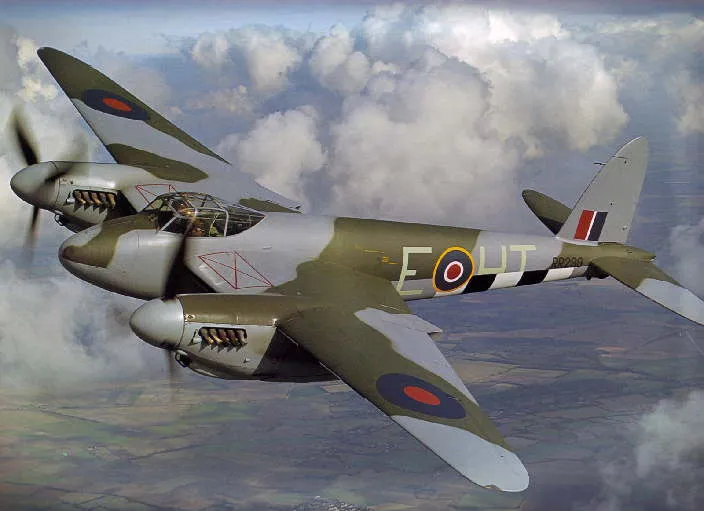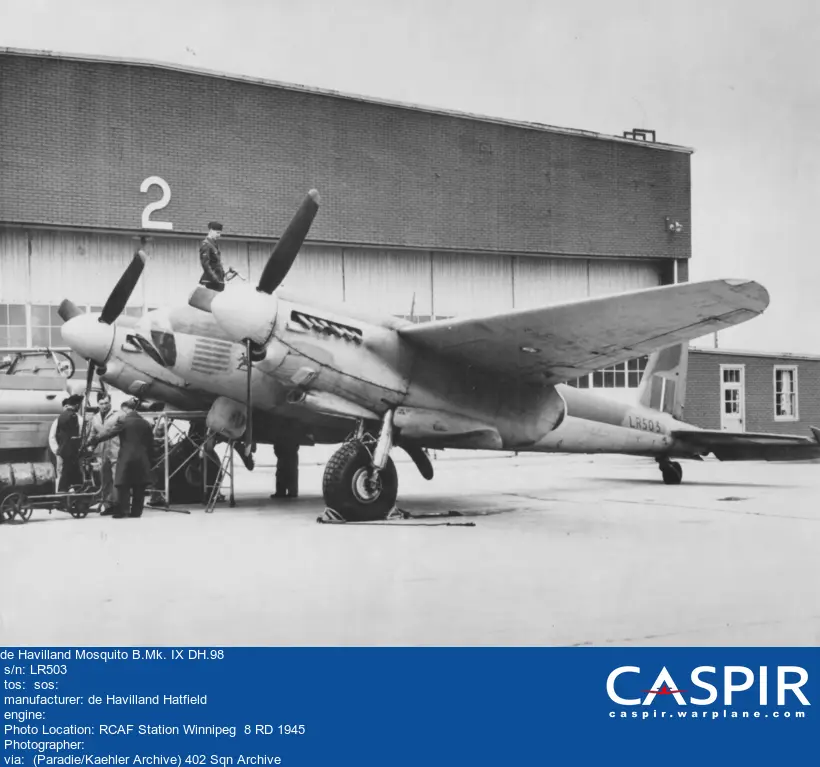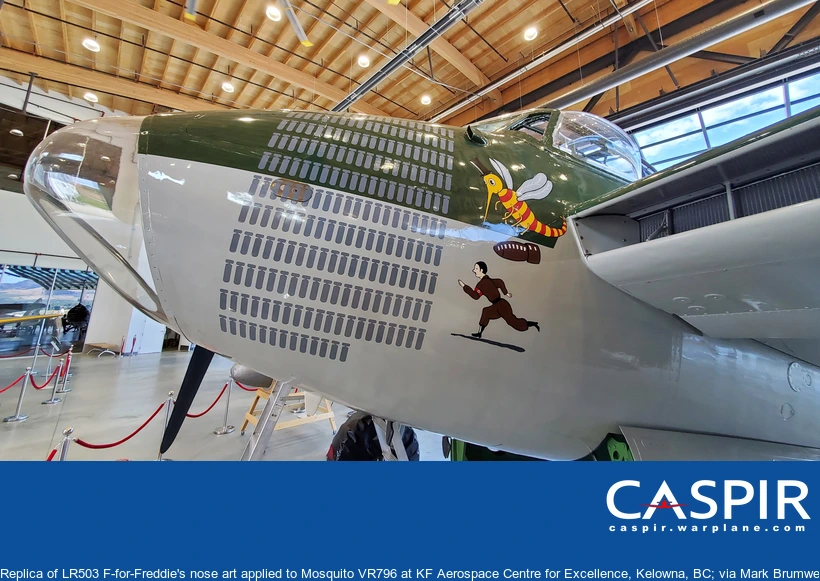Briggs, M (Flight Lieutenant)
Killed in Flying Accident 1945-05-10


Birth Date: unkown date
Born:
Home:
Enlistment:
Enlistment Date: Unknown
Service
RAF
Unit
105 Sqn- Squadron (RAF)
Fortis in Proeliis Valiant in battles
Base
RAF Bourn
Rank
Flight Lieutenant
Position
Flight Lieutenant
Service Numbers
47348
de Havilland Mosquito

The de Havilland DH.98 Mosquito was a British twin-engine shoulder-winged multi-role combat aircraft, introduced during the Second World War. It was one of few operational front-line aircraft of the era whose frame was constructed almost entirely of wood. Nicknamed The Wooden Wonder, it was affectionately as the "Mossie" to its crews. The total number of DH98 Mosquito aircraft built was 7,781, the type serving with the main Allied air forces, including both the United States and Russia.
When Mosquito production began in 1941 it was the fastest propeller driven operational aircraft in the world. The first variant was an unarmed, high-speed, high-altitude photo-reconnaissance aircraft. Originally conceived as an unarmed fast bomber, the Mosquito's use evolved during the war into many roles including low to medium-altitude daytime tactical bomber, high-altitude night bomber, pathfinder, day or night fighter, fighter-bomber, intruder, and maritime strike aircraft. It was also used by the British Overseas Airways Corporation (BOAC) as a fast transport to carry small high-value cargoes to, and from, neutral countries, through enemy-controlled airspace. The crew of two, pilot and navigator, sat side by side, but a single passenger could ride in the aircraft's bomb bay when necessary.
The Mosquito FB Mk. VI was often flown in special raids, such as Operation Jericho, an attack on Amiens Prison in early 1944, and precision attacks against military intelligence, security and police facilities (such as Gestapo headquarters). On the 10th anniversary of the Nazi' seizure of power in 1943, a morning Mosquito attack knocked out the main Berlin broadcasting station while Hermann Goering was speaking, putting his speech off the air. Goering later said: "It makes me furious when I see the Mosquito. I turn green and yellow with envy. There is nothing the British do not have. They have the geniuses and we have the nincompoops."
The Mosquito flew with the RCAF and other air forces in the European, Mediterranean and Italian theatres. After the end of the Second World War Spartan Air Services flew 10 ex-RAF Mosquitoes, mostly B.35's plus one of only six PR.35's built, for high-altitude photographic survey work in Canada. There are approximately 30 non-flying Mosquitos around the world with five airworthy examples, four in the United States, and one in Canada. Harold Skaarup web page and Wikipedia
 BAE Systems (formerly De Havilland)
BAE Systems (formerly De Havilland)
Mosquito LR503
Mosquito B.Mk. IX LR503
 F
FNear the end of the war in Europe, the National War Finance Committee in Canada had requested a famous RAF aircraft and/or aircrew to support a Victory bond drive. At first, 105 Sqn was to send aircraft GB-D but it had suffered a number of mechanical problems and LR503 (known as F-for-Freddie with the 105 Sqn code GB-F-bar) replaced it. The crew was experienced: Flight Lieutenant J. Maurice W. Briggs, DFM, DFC, DSO, and Flying Officer John C. Baker, DFC and bar had flown 107 trips in Mosquito B.Mk. IXs with 1409 Meteorological Flight, flying in daylight and assessing weather conditions over Europe ahead of planned bombing missions. At the end of 1944 they were both transferred to 45 Group (formerly Ferry Command) and delivered several new Canadian-built Mosquitos to Britain.
Briggs and Baker flew LR503 via the North Atlantic Ferry Route in the westbound direction, completing the final non-stop leg from Greenland to Ottawa-Rockliffe on 2 May 1945 in record time. In the next few days the tour passed through Montreal, Toronto, Downsview, Winnipeg, Regina and Saskatoon, passing over as many smaller centres as possible along the way, entertaining (or annoying) the population with displays of very low and fast flying. They arrived in Calgary on 9 May, making extremely low passes between the major downtown buildings as well over as the airport itself. There were reports of the Mosquito passing under a trestle bridge in the city. Briggs had completed his BCATP pilot training in Calgary in 1943. A crowd had gathered at Calgary airport on the afternoon of 10 May to see LR503 fly. After some delays due to engine adjustments, Briggs and Baker took off and made 2 very fast low passes over the Calgary control tower and the crowd. On the third pass, LR503 struck weather equipment and a flagpole on top of the Calgary control tower, shearing off the left wing and the tailplane. The aircraft crashed and burned in a field some distance away, taking the lives of the crew.
{{link,general,https://www.bombercommandmuseum.ca/chronicles/f-for-freddie-calgarys-ve-day-tragedy/,Calgary's V-E Day Tragedy}}
1943-05-28 Taken on Strength 109 Sqn Wyton GB 2024-03-27
1944-03-10 Transferred 105 Sqn Bourn GB 2024-03-27
1945-May-10 Accident: 45 GROUP RAF Loc: Calgary Names: Baker | Briggs
1945-05-10 Struck off Strength Calgary CA after Cat. "E" fatal crash 2024-03-27


 Library and Archives Canada Service Files (may not exist)
Library and Archives Canada Service Files (may not exist) Mosquito
Mosquito Wikipedia Mosquito
Wikipedia Mosquito Harold A Skaarup Web Page
Harold A Skaarup Web Page USAAF F-8 Mosquito Serial Numbers
USAAF F-8 Mosquito Serial Numbers Mosquitos shipped to Taiwanese Airforce
Mosquitos shipped to Taiwanese Airforce